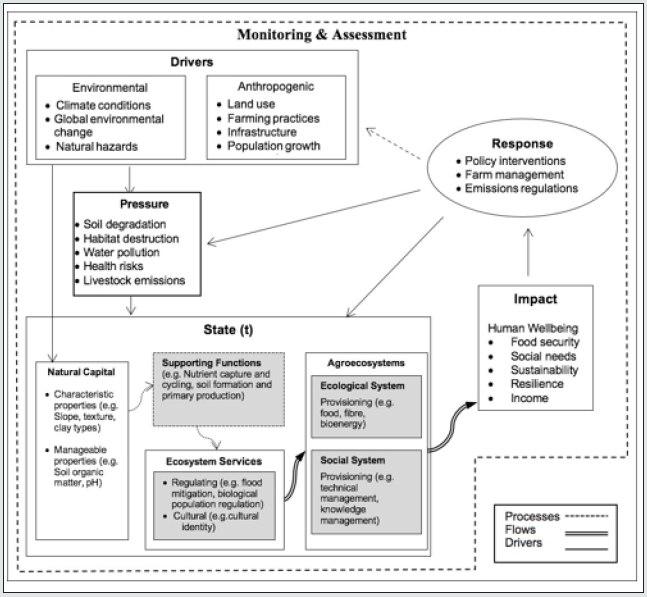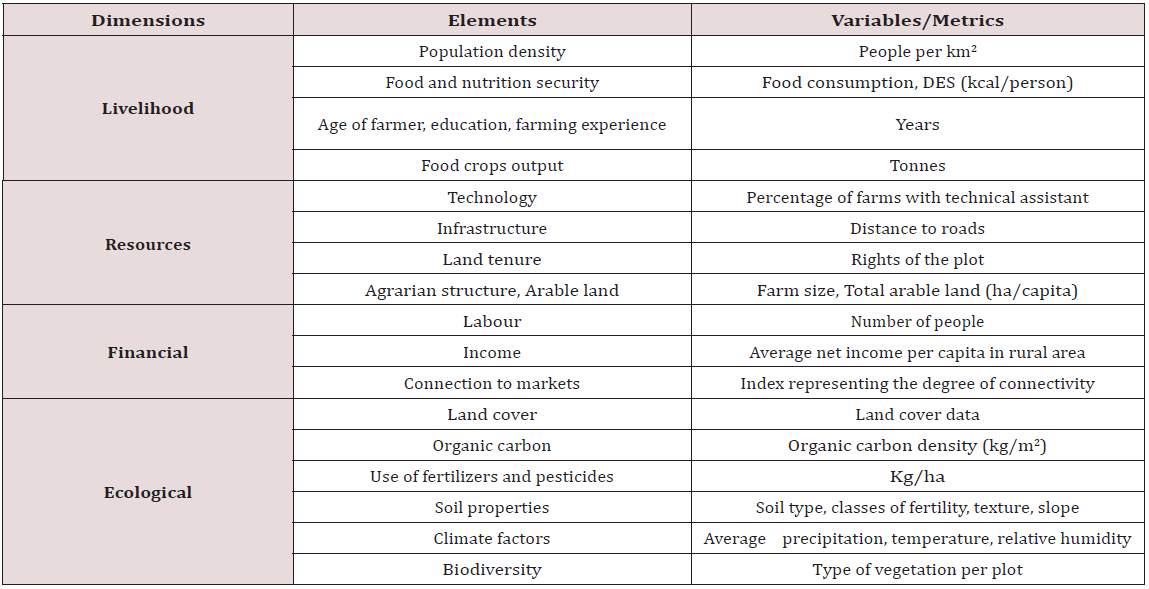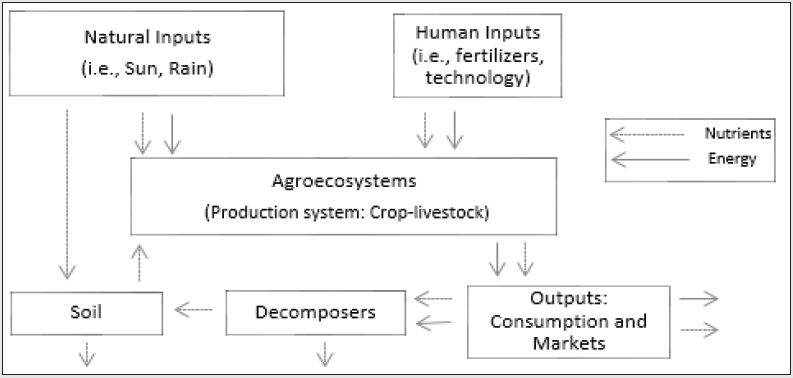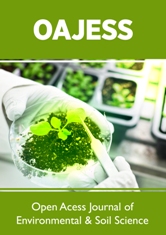
Lupine Publishers Group
Lupine Publishers
Menu
ISSN: 2641-6794
Mini Review2641-6794 
Exploring Connections in Agroecosystems Volume 6 - Issue 1
Elisavet Zoupanidou
- Geneva School of Social Sciences University of Geneva, Switzerland
Received: March 23, 2021 Published: April 7, 2021
Corresponding author: Elisavet Zoupanidou, Geneva School of Social Sciences University of Geneva, Switzerland
DOI: 10.32474/OAJESS.2021.06.000230
Abstract
A challenge of the Anthropocene is to advance human development without undermining critical natural processes. At the heart of this challenge is a better understanding of the interactions and feedbacks between nature, ecosystem services, and human wellbeing, in dynamic and complex social-ecological systems. These interrelationships have been the focus of much work in the past decades, however, more remains to be done to identify and quantify them, at different scales.
Keywords: Agroecosystems; Ecosystem Service; Resilience; Soil Functions; Research Frameworks
Introduction
Agroecosystems as described by Gliessman [2] is a framework with which to analyze food production systems as wholes including their complex sets of inputs and outputs and the interconnections of their components parts. Agroecosystems are ecological systems transformed and simplified for the purpose of producing food, fiber, or other agricultural products Falco, et al. [1] They are very productive suppliers of biomass-related provisioning ecosystem services, e.g. food, timber, and energy. At the same time, they are connected and highly dependent with natural ecosystems, particularly with soils’, and their ecological principles and conditions, such as soil fertility, water supply or soil erosion regulation. Human transformation and alteration of ecosystems, for the purpose of converting natural landscapes for establishing agricultural production, makes agroecosystems very different from natural ecosystems. However, some of the characteristics, structure and processes of natural ecosystems are still fundamental in agroecosystem’s function. Assessments of this interplay of ecosystem conditions and services are very important to understand the relationships in highly managed systems. (Figure 1) illustrates the dynamic processes occurring within an agroecosystem. Solid lines represent the flows of energy, whereas dashed lines show movements of nutrient. It is crucial to understand these processes because the function of the agroecosystem will determine the difference between the success and failure of management practices Gliessman, et al. [2].
Soil ecosystem services (ES), which are of particular
importance for agroecosystems, are the maintenance of the
genetic diversity, the nutrient cycles, the biological control of
pests and diseases, erosion control and sediment retention, and
water regulation Swift, et al. [3]. Soil ES have been the subject
of multiple scientific researchers over the years. Ecologists and
biologists are studying the supporting services and ecosystem
processes of soil, i.e., soil formation, soil binding by vegetation.
Benefits for human beneficiaries more often are translated into
economic values studied by social scientists, i.e., avoided erosion
and sedimentation, water for agriculture.
Agroecosystems depend on ES to function and be
productive. Sustain ES ensures the resilience of agroecosystems
as pointed to meet the stress of global challenges. Soil is a vital
pore for life, representing an economic asset, particularly for
agriculture, which is one of the main activities of the use of
soil resources. Global changes increasingly influence soils,
their biodiversity, and the ecosystem services that they
provide. Since the agricultural sector constitutes a significant part
of the economy of several countries, this indicates the need for
sustainable soil and land management practices. Different land-use
planning, mechanisms, and policies could mitigate some effects of
agricultural expansion by identifying where soil natural capital is
limiting and how it can be improved.
The unique role of soils in influencing the management and use
of other resources such as water, land, nutrients, and biodiversity
validates the efforts of the scientific community towards integrated
resource management. Agriculture, and consequently, soils are
at the heart of the Sustainable Development Goals (SDGs) and
fundamental to achieving them. The SDGs lay the groundwork in the
quest to achieve a healthy and sustainable future for our planet. The
unique position of soils as a link between the use and management
of other natural resources makes it useful in the overall assessment
of ecosystems allowing relevant actors and stakeholders, e.g.,
scientists, economists, policymakers, to connect different SDGs and
actions towards a common goal Keesstra, et al. [4]. For instance,
SDGs 2, 3, 6, 13, 14, and 15 have targets that explicitly bind them
with soil functions and ecosystem services. The success of the SDGs
rests, to a large extent, on effective accounting, monitoring, review,
and follow-up processes.
Proposed framework for agroecosystems
This section aim is to explore the links between anthropogenic
activities and the ecosystems, focusing on the intersection of
agroecosystems, soil natural capital and human well-being.
Critical physical and social components of human well-being
are dependent on well-functioning ecosystems, e.g.., quality and
quantity of nutritious food, clean water, stable income, integrated
communities, preservation of ecology. The objective is to provide
a broader conceptual framework that consistently accounts for the
above relationships, also exploring the feedback effects.
ES are defined as the beneficial flows (amount per unit time)
of services-depend on natural capital stocks (total amount)-from
ecosystems to societal groups and fulfill human needs. For instance,
soil structure can supply nutrients. The provision of the ecosystem
service ‘support plant growth’ depends on the amount of soil
organic carbon in the soil (stock) and the timing of the availability
of the storage volume regarding a land use change. Furthermore,
the value of these services depends on the beneficiary’s usage. The
important first step is to frame and understand the interacting
ecological and societal processes in interest. A Driver-Pressure-
State-Impact-Response approach is a framework that captures
the cause-effect relationships of a system and assisting in many
steps of the decision process Lewison, et al. [5]. This framework
could be used for structuring problems and facilitating empirical
research for agroecosystems planning. The DPSIR framework starts
by identifying the various driving forces, e.g., political, economic,
ecological, demographic, and social, that cause direct pressure on
the state of SESs and impact their ability to deliver a range of ESs.
Eventually, changes in SESs lead to societal responses to mitigate
pressures Rounsevell, et al. [6]; Gupta, et al. [7].
The framework in (Figure 2) assumes cause–effect
relationships between interacting components of social, economic,
and environmental systems, which are described below and
exemplified through the issue of land use and soil natural capital
and ES provision:
a) Driving forces of natural and anthropogenic change (e.g.,
increasing atmospheric greenhouse emissions and land use
change)
b) Pressures on the SES (e.g., soil degradation and livestock
emissions)
c) State of the environment (e.g., lowered crop production)
d) Impacts on population, economy, ecosystems (e.g., food
insecurity)
e) Response of society (e.g., policy response, such as the Kyoto
protocol for reducing greenhouse gas emissions and car or the
EU Common Agricultural Policy).
Pressures refer to the state of the natural capital stocks and
processes, which in turn affect the input flows in the agroecosystem.
Ecosystem services flow from natural capital stocks and processes
and create benefits and value for the societies. This interpretation
of state deviates from suggestions within the scientific community
Sch¨oßer, et al. [8]; Helming, et al. [9] who have continued to consider
ES changes as parts of the state, and have evaluated impacts only in
terms of changes in human well-being. I argue, however, that social
aspects of agroecosystems are defined as contributions to human
well-being, and changes of these can therefore be best assessed as
parts of the state component.
In this framework, I use an example of an agricultural area
as a demonstration. The value of agricultural land is based on
three factors, productive capacity, location, and beneficiaries.
The service is the part of an ecosystem function, which is the
supply that intersects with human locations and activities. So, it is important to define a context to delineate the area over which
this service operates and where the demand for the service is. The
area should be selected in terms of potential service improvement
by paying attention to the relationships and trade-offs between
soil ES and land assets and people’s access to these values. Finally,
to better understand how each of the system’s dimensions varies
and interacts requires adequate monitoring and assessment of
all its components and the subsequent dissemination of data and
products. Based on available data for the research area, a causal
analysis can be performed to explore the relationship between
different drivers and identify those that significantly influence ES
and human well-being. The description of all the causal chains of
the framework will allow selecting the indicators that significantly
impact the DPSIR sectors. Despite existing investigations, less work
has been done on demonstrating the mutual
Discussion
Apart from describing the relationships in figure 2 conceptually, it remains to quantify and address them physically in terms of spatial boundaries, relations and synergies with the surrounding social and natural world and distinguish the different sources of inputs to an ecosystem Bagstad, et al. [11]. A critical point that remains a challenge within the conceptual frameworks is to differentiate between ecosystems functions and processes, their services to human well-being and the generating benefits to avoid the double counting but also to use the correspondent indicators for their evaluation Silvia Silvestri [12]. (Table 1) presents an example of an initial set of indicators that could serve as a basis for the development of the described framework (Figure 2). Furthermore, to analyze potential future consequences of alternative land uses for both soil conservation and economic objectives, scenario analysis can be used identify determining factors.
Figure 2: Conceptual DPSIR framework for human-agricultural systems interaction cycle. The framework applies to the agricultural territory. The arrows represent the interplay of structure and processes. The structural part of the state components ‘Social system’ refers to human inputs such as sociotechnical networks, collectives, planning, or agroecosystem management. The ‘Monitoring and assessment involves the outline of a set of recommendations for indicators, monitoring procedures and the evaluation of the DPSIR steps. The text in the boxes is illustrative, not exhaustive. (DPSIR framework originally developed by the European Agency for Environment).

Table 1: Initial elements for building up the framework for valuing and quantifying ES in an agroecosystem.

Different scenarios can identify mixed strategies that could be used to compare with the baseline scenario, which does not account for any policy and further intervention for the role of soil ES in production decisions. In the DPSIR framework baseline scenario represents the increased pressures while the alternative scenarios are capturing response measures. The scenario approach will also allow assessing how choices in public policy can influence change by building different strategies considering various policy options. For example, as part of the global warming mitigation strategies, to estimate the reduction in CO2 emission caused by the sequestration of soil organic carbon (SOC), because of alternative farm practices that increased SOC storage. The most important for a practical analysis is to develop scenarios appropriate for the context and have the potential to yield information that advances decision making McKenzie, et al. [13]
Conclusion
This qualitative study demonstrates the potential of the DPSIR framework for analyzing and structuring leading cause and effects problems of agroecosystems. Thus, it is an aid to sustainable governance through developing strategies and targeted policies towards systems thinking approach. This framework identifies that, apart from the critical ecological aspects, social aspects of agroecosystems are defined as contributions to human well-being, and changes of these can therefore be best assessed as parts of the agroecosystem’s state. The discussed framework must be applied empirically to accurately monitor and quantify the multiple elements of the system status.
References
- Salvatore Di Falco, Jean-Paul Chavas (2008) Rainfall shocks, resilience, and the effects of crop biodiversity on agroecosystem productivity. Land Economics 84(1):83-96.
- Stephen R Gliessman, Eric Engles (2014) Agroecology: The ecology of sustainable food systems. 3rd Edition CRC Press
- Swift MJ, Izac AMN, van Noordwijk M (2004) Biodiversity and ecosystem services in agricultural landscapes-are we asking the right questions? Agriculture, Ecosystems Environment, 104(1): 113-134.
- Keesstra SD, Bouma J, Wallinga J, Tittonell P, Smith P, et al. (2016) The significance of soils and soil science towards realization of the united nations sustainable development goals. SOIL 2(2):111-128.
- Rebecca L Lewison, Murray A Rudd, Wissam Al-Hayek, Claudia Baldwin, Maria Beger, et al. (2016) How the dpsir framework can be used for structuring problems and facilitating empirical research in coastal systems. Environmental Science Policy 56: 110-119.
- Rounsevell MDA, Dawson TP, Harrison PA (2010) A conceptual framework to assess the effects of environmental change on ecosystem services. Biodivers Conserve 19: 2823-2842.
- Joyeeta Gupta, Joeri Scholtens, Leisa Perch, Irene Dankelman, Joni Seager, et al. (2020) Re-imagining the driver–pressure–state–impact–response framework from an equity and inclusive development perspective. Sustainability Sciences 15(2): 503-520.
- Sch¨oßer B, Helming K, Wiggering H (2010) Assessing land use change impacts-a comparison of the sensor land use function approach with other frameworks. Journal of Land Use Science, 5(2):159-178.
- Katharina Helming, Katharina Diehl, Davide Geneletti, Hubert Wiggering (2013) Mainstreaming ecosystem services in European policy impact assessment. Environmental Impact Assessment Review, 40: 82-87.
- Ying Hou, Shudong Zhou, Benjamin Burkhard, Felix Mu¨ller (2014) Socioeconomic influences on biodiversity, ecosystem services and human well-being: a quantitative application of the dpsir model in jiangsu, china. The Science of the total environment 490: 1012-1028.
- Kenneth J Bagstad, Gary W Johnson, Brian Voigt, Ferdinando Villa (2013) Spatial dynamics of ecosystem service flows: A comprehensive approach to quantifying actual services. Ecosystem Services 4: 117-125.
- Silvia Silvestri (2010) TEEB, The economics of ecosystems and biodiversity ecological and economic foundations. Earthscan, London and Washington 245-252.
- Emily McKenzie, Amy Rosenthal, Joey Bernhardt, Evan Girvetz, Kent Kovacs, et al. (2012) Developing scenarios to assess ecosystem service tradeoffs: Guidance and case studies for invest users. World Wildlife Fund, Washington

Top Editors
-

Mark E Smith
Bio chemistry
University of Texas Medical Branch, USA -

Lawrence A Presley
Department of Criminal Justice
Liberty University, USA -

Thomas W Miller
Department of Psychiatry
University of Kentucky, USA -

Gjumrakch Aliev
Department of Medicine
Gally International Biomedical Research & Consulting LLC, USA -

Christopher Bryant
Department of Urbanisation and Agricultural
Montreal university, USA -

Robert William Frare
Oral & Maxillofacial Pathology
New York University, USA -

Rudolph Modesto Navari
Gastroenterology and Hepatology
University of Alabama, UK -

Andrew Hague
Department of Medicine
Universities of Bradford, UK -

George Gregory Buttigieg
Maltese College of Obstetrics and Gynaecology, Europe -

Chen-Hsiung Yeh
Oncology
Circulogene Theranostics, England -
.png)
Emilio Bucio-Carrillo
Radiation Chemistry
National University of Mexico, USA -
.jpg)
Casey J Grenier
Analytical Chemistry
Wentworth Institute of Technology, USA -
Hany Atalah
Minimally Invasive Surgery
Mercer University school of Medicine, USA -

Abu-Hussein Muhamad
Pediatric Dentistry
University of Athens , Greece

The annual scholar awards from Lupine Publishers honor a selected number Read More...





